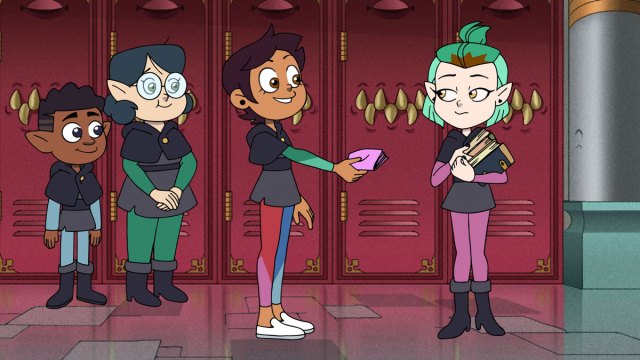Kids like my son are growing up watching queer characters on cartoon shows, and they are better for it
A few months ago, my son pleaded with me to watch a show called The Owl House with him. The Disney animated series stars a young Dominican-American girl named Luz who finds herself in a magical realm and winds up becoming a witch’s apprentice. Right off the bat, I was excited to dive in thanks to the subject matter (magic! witches!) and the fact that the lead was a Latina like me.
But then I found that there was another form of representation I was seeing onscreen. Like me, Luz was queer. And other characters were, too! That’s when I began to notice a trend in children’s cartoons, including many of the ones my son watches; something I hope is here to stay: LGBTQ+ characters are becoming the norm in kids’ cartoons. Frankly, it’s about time.
When I was a kid, we had a few “suspected” queer cartoon characters on television. Miss Frizzle from the Magic School Bus, for one. Every lead kid on Pepper Ann, for another. Then some characters were queer but weren’t allowed to be out yet—at least not on American television. Specifically, I’m talking about Sailor Moon. It took years before I found out that two of the villains in season one were a gay couple because the U.S. dub changed the gender and pronouns of one of the men so they might appear as a heterosexual couple. The U.S. dub also waited a long while before releasing episodes with lesbian couple Sailor Uranus and Sailor Neptune and then depicted them as, er, very close cousins.
It would be over a decade from the time I realized I was queer until I finally began to see openly out characters on screen. Why all the fuss? Well, there are still a lot of folks who remain as homophobic, transphobic, and otherwise anti-queer as ever. In 2017, conservative group One Million Moms made a fuss over the inclusion of two moms in a Doc McStuffins episode. Three years later, the same group decided to protest the addition of gay dads in the modern remake of DuckTales. And just this month, conservative commentators were clutching their pearls at Scooby Doo’s Velma finally getting a queer storyline (as if we hadn’t always suspected). And despite queer representation being at an all-time high on television, there are still frequent efforts by pundits, legislators, and others with entirely too much time on their hands to put an end to this.
Despite the hand-wringing about queer cartoon characters on kid’s TV, it’s important to recognize this kind of representation can be life-altering if not life-saving. Being a queer child, tween, or teen growing up in a world that often doesn’t accept or include you—much less celebrate you—can be extremely difficult, isolating, and even dangerous.
According to the Trevor Project, nearly half of all LGBTQ+ youth seriously contemplated attempting suicide in the past year, and 14% actually attempted to end their lives. I know I contemplated it often in my early teen years, in part thanks to anti-queer harassment I endured in school and a lack of support at home. But those who felt they had a lot of support at home reported attempting suicide at less than half the same rate as those who only had low or moderate support. And while watching cartoons with queer characters isn’t going to change everyone’s mind, inclusion and positive representation do make an impact on how people perceive LGBTQ+ people in real life.
“I want my daughter to see her real world reflected in her shows and movies,” says Jillian Bishop of New Hampshire. Her six-year-old daughter watches Jurassic World: Camp Cretaceous, another show my son also watches, and which features a queer couple. “Seeing different types of relationships just makes sense since it's the world we live in, and it lets her know these relationships are absolutely ok, healthy, and acceptable.”
Meg St. Esprit, a writer and mother of four in Pittsburgh, says her multiracial family enjoys watching shows like Steven Universe because they find all representation to be important and seek out diversity beyond what directly affects them.
“At this point, none of the six of us in our household identify as queer, but many friends and family members do. It’s vital our kids see these people are valuable and worthy of respect and rights,” St. Esprit says. “Kids learn through imagination and play, so shows with queer characters are much more effective than me just talking at my kids.”
While I felt practically invisible growing up as a queer young girl, my son frequently sees queer and trans characters on his screen shown in a positive light. Moreover, most of them exist in a world where they are simply accepted for who they are. He’s growing up with shows like She-Ra and the Princess of Power, Gravity Falls, Adventure Time, The Loud House, and so many others where diversity is celebrated and accepted.
Plus, because we’ve always normalized LGBTQ+ people, he’s growing up accepting of others no matter their gender or orientation and accepting of himself and whoever he grows up to be. As for me, in watching these shows with my son, I’m doing a lot of healing of my inner child, something nine-year-old me would’ve never even dreamed of.
